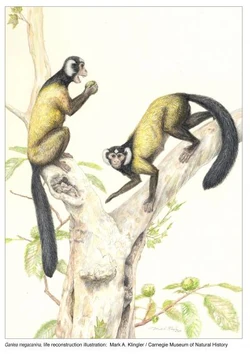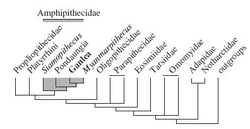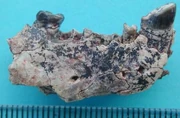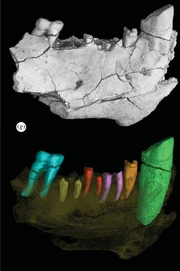| Ganlea Fossil range: Eocene (Bartonian) 38 Ma | |
|---|---|
 A somewhat tamarin-like restoration of Ganlea megacania. | |
| Scientific classification
| |
|
Class |
|
|
Order |
|
|
Suborder |
Anthropoidea (Haplorrhini) |
|
Infraorder |
Anthropoidea |
|
Family |
Amphipithecidae |
|
Genus |
Ganlea |
| |
Ganlea is an extinct genus of amphipithecid anthropoid primate that lived during the Bartonian stage of the Eocene epoch. It is possibly related to New World monkeys and often fed on seeds and tough-skinned fruit. The type specimen was officially described in 2009 and is from the Pondaung Formation in Myanmar. It is based on jaw fragments and assorted teeth. The teeth of Ganlea clearly group it with other amphipithecid primates from the area like Myanmarpithecus and Podaungia, and together these primates appear to belong to a monophyletic group (or they all shared a recent common ancestor and are closely related). One key trait shared among these primates is a canine tooth that is compressed front-to-back so that it is wider than it is long. This and other minute details of the teeth appear to be unique characteristics of this group. There has been some debate as to how amphipithecids might relate to each other and other primates in general. Some scientists have seen them as anthropoids (the group that contains monkeys and apes) or as adapiforms (an extinct group of lemur-like primates that includes Darwinius). An interesting characteristic of Ganlea is a huge canine tooth (hence the species name "megacania") that has a wear facet from overuse and wear. The authors of the paper proposed that Ganlea (as well as the other amphipithecids) often fed on hard seeds and nuts that abraded the canines of these primates. The large lower canines of Ganlea, in particular, might have been an adaptation to this particular feeding niche.[1][2]
Cladistics[]

A hypothesis as to the evolutionary place of Ganlea and other amphipithecids.
The cladistic analysis undertaken by the researchers of the paper discovered that these primates were closely related to New World monkeys (platyrrhines) and an extinct group of anthropoid primates called propliopithecids (represented by creatures like Aegyptopithecus from the Fayum region of Egypt). Which of the two groups the amphipithecids were more closely related to is as yet uncertain, but this placement means that that the amphipithecids were anthropoid primates, not adapiforms.
Amphipithecids do not sit near the base of the anthropoid evolutionary tree, such as the fossil primate Eosimias, but are more evolutionarily specialized. More fossil material will have to be discovered to further compare Ganlea and other amphipithecids to other fossil anthropoids to further test the hypotheses of the authors.

The greatly enlarged canine teeth distinguish the animal from closely related primates. Heavy dental abrasion indicates that Ganlea megacanina used its enlarged canine teeth to pry open the hard exteriors of tough tropical fruits in order to extract the nutritious seeds contained inside.

A lateral view of the right lower jaw of Ganlea. Note the size of the large canine (in green) and the presence of a single-rooted second premolar (yellow).
The main point of contention with Ganlea is the phylogenetic position that it and its relatives, with respect to other living and fossil primatesoccupy. The phylogenetic analysis presented in Beard et al. indicates that Ganlea and other amphipithecids are nested within the clade that includes living New World and Old World anthropoid primates (as well as the extinct Propliopithecidae, which are unanimously regarded as early catarrhines, or Old World anthropoids, by primate paleontologists). Anatomical evidence for amphipithecids is so far restricted to data from the teeth and jaws and one ankle bone--the astragalus (= talus of human anatomy). Despite this paucity of anatomical evidence, amphipithecids appear to be relatively derived anthropoids or "crown anthropoids". Amphipithecids are older than any well-documented anthropoid primates known from Africa, probably by about 3 million years. Disparity in the age of the earliest records of a given taxon in different places is one criterion for reconstructing historical biogeography, and the antiquity of Ganlea and other amphipithecids is therefore consistent with an Asian origin for Anthropoidea as a whole.
More compelling evidence that anthropoids arose in Asia comes from more basal taxa of anthropoids, such as Eosimias and its close relatives (including Bahinia, which lived alongside Ganlea in Myanmar 38 million years ago). Eosimiids are "stem anthropoids," meaning that they occur on the root of the anthropoid family tree. All living anthropoids, and presumably Ganlea, shared a single common ancestor for some unknown interval of time after Eosimias and its relatives had diverged evolutionarily. Eosimiids are so far only known from Asia. Their basal phylogenetic position with respect to "crown anthropoids" and their great antiquity (~45 million years) provides especially compelling evidence for an Asian origin for Anthropoidea.
The final piece of evidence for reconstructing the continental birthplace of anthropoids comes from the living sister taxon of Anthropoidea, which consists of modern tarsiers. Tarsiers are currently restricted to islands belonging to the Philippine archipelago and the eastern part of Indonesia (as well as northern Borneo, which is politically part of Malaysia and Brunei). Fossil tarsiers have been found on the Asian mainland, but never in Africa (Afrotarsius from the Fayum region of Egypt is misnamed--it is almost certainly an early anthropoid and not a tarsier). By definition, the anthropoid lineage (or clade) originated when it split apart from the lineage leading to modern tarsiers. Given the geographic restriction of tarsiers, anyone who wishes to argue that anthropoids originated someplace other than Asia has to explain why tarsiers are currently endemic to that landmass (as well as the distribution of fossil taxa like eosimiids and amphipithecids).
Media reports[]
Media press releases hail Ganlea as an alternative link to humanity,[3][4][5] however nothing in the paper suggests that this new fossil anthropoid is one of our ancestors or a common ancestor of monkeys and apes. It is only being marketed as a competitor to Darwinius to get it more attention.
A news report by The Independant[6] stated that Ganlea represented the "ultimate ancestral group of all anthropoids," thus making it one of our ancestors. Since humans are apes, and apes are anthropoid primates, the last common ancestor of all anthropoids would be one of our distant primate ancestors. However Ganlea is more closely related to New World monkeys, a branch of the primate family tree that did not give rise to apes or humans. The press release by ScienceDaily[5] and the press office of the Carnegie Museum of Natural History have misled the public about what the paper describing Ganlea says and its relevance to primate evolution.
Press releases and public relations announcements are misrepresenting Ganlea. The information being passed on to the public is being overblown to attract a wider audience, and this obscures the real scientific significance of the discovery.
See also[]
References[]
- ^ http://scienceblogs.com/laelaps/2009/07/ganlea_megacania_and_more_miss.php
- ^ K. Christopher Beard, Laurent Marivaux, Yaowalak Chaimanee, Jean-Jacques Jaeger, Bernard Marandat, Paul Tafforeau, Aung Naing Soe, Soe Thura Tun, and Aung Aung Kyaw. A new primate from the Eocene Pondaung Formation of Myanmar and the monophyly of Burmese amphipithecids. Proc. R. Soc. B doi:10.1098/rspb.2009.0836
- ^ http://news.yahoo.com/s/ap/20090701/ap_on_sc/as_sci_myanmar_primate_fossil
- ^ http://www.scientificblogging.com/news_articles/ganlea_megacanina_move_over_ida_asia_lays_claim_human_common_ancestor
- ^ a b http://www.sciencedaily.com/releases/2009/06/090630202125.htm
- ^ http://www.independent.co.uk/news/science/rival-fossil-challenges-missing-link-1726210.html